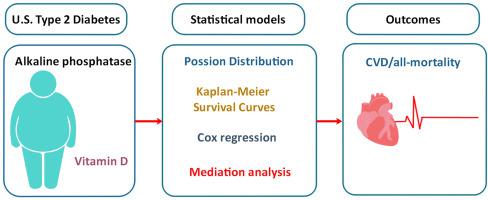当前位置:
X-MOL 学术
›
Atherosclerosis
›
论文详情
Our official English website, www.x-mol.net, welcomes your
feedback! (Note: you will need to create a separate account there.)
Predicting life span of type 2 diabetes patients through alkaline phosphatase and vitamin D: Results from NHANES 1999–2018
Atherosclerosis ( IF 4.9 ) Pub Date : 2023-10-05 , DOI: 10.1016/j.atherosclerosis.2023.117318 Fan Yang 1 , Mingsi Wang 2 , Jie Du 3 , Yao Fu 4 , Jingwen Deng 3 , Jianjun Wu 3 , Yao Zhang 3 , Yilan Li 3
Atherosclerosis ( IF 4.9 ) Pub Date : 2023-10-05 , DOI: 10.1016/j.atherosclerosis.2023.117318 Fan Yang 1 , Mingsi Wang 2 , Jie Du 3 , Yao Fu 4 , Jingwen Deng 3 , Jianjun Wu 3 , Yao Zhang 3 , Yilan Li 3
Affiliation

|
Disparities in serum biomarker levels related to mortality persist within the US diabetic population. We conducted a study to explore the impact of alkaline phosphatase (ALP) on all-cause mortality and cardiovascular disease (CVD) mortality in type 2 diabetes patients. We analyzed a nationally representative sample of individuals aged 20 years and above from the National Health and Nutrition Examination Survey (NHANES) conducted in the United States between 1999 and 2018. Baseline demographic information and biochemical markers, including blood glucose, γ-glutamyltranspeptidase, vitamin D and albumin, were collected. Participants were divided into four groups based on ALP levels and linked to the National Death Index to assess mortality. Follow-up continued until December 2019, and multiple mediation analyses were performed to assess the combined impact of different indicators on ALP differences in all-cause mortality and cardiovascular mortality risk. Our analysis included 6481 NHANES participants, categorized as follows: 1626 (21.9%) had ALP levels below 58 U/L, 1674 in the second quartile (58–72 U/L), 1569 in the third quartile (72–88.3 U/L), and 1612 in the fourth quartile (above 88.3U/L). Significantly higher all-cause mortality and cardiovascular mortality rates were observed among participants in the 4th ALP quartile compared to other levels. The all-cause mortality rate was 38.06 per 1000 person-years (95% CI 34.89–41.51), and the cardiovascular mortality rate was 10.67 (9.06–12.57). Mediation analysis indicated that Vitamin D and albumin played a mediating role in the association between all-cause mortality, cardiovascular mortality, and ALP levels, with mediation proportions ranging from 10.33% to 27.64%. Our study suggests that ALP levels have clinical value in predicting all-cause and CVD mortality risk in T2DM patients. The upregulation of Vitamin D and albumin might play a significant role in improving risk prediction and enable targeted interventions for reducing mortality risk in this population.
中文翻译:

通过碱性磷酸酶和维生素 D 预测 2 型糖尿病患者的寿命:NHANES 1999-2018 的结果
在美国糖尿病人群中,与死亡率相关的血清生物标志物水平存在差异。我们进行了一项研究,以探讨碱性磷酸酶 (ALP) 对 2 型糖尿病患者全因死亡率和心血管疾病 (CVD) 死亡率的影响。我们分析了 20 年至 1999 年间在美国进行的全国健康和营养检查调查 (NHANES) 中具有全国代表性的 2018 岁及以上个人样本。收集基线人口学信息和生化标志物,包括血糖、γ-谷氨酰转肽酶、维生素 D 和白蛋白。参与者根据 ALP 水平分为四组,并与国家死亡指数相关联以评估死亡率。随访持续到 2019 年 12 月,并进行了多项中介分析,以评估不同指标对全因死亡率和心血管死亡风险 ALP 差异的综合影响。我们的分析包括 6481 名 NHANES 参与者,分类如下:1626 名 (21.9%) 的 ALP 水平低于 58 U/L,第二四分位数 1674 名 (58-72 U/L),第三四分位数 1569 名 (72-88.3 U/L),第四四分位数 1612 名 (高于 88.3U/L)。与其他水平相比,第 4 个 ALP 四分位数的参与者观察到全因死亡率和心血管死亡率显着升高。全因死亡率为 38.06/1000 人年 (95% CI 34.89-41.51),心血管死亡率为 10.67 (9.06-12.57)。中介分析表明,维生素 D 和白蛋白在全因死亡率、心血管死亡率和 ALP 水平之间的相关性中起中介作用,中介比例范围为 10.33%—27.64%。 我们的研究表明,ALP 水平在预测 T2DM 患者的全因和 CVD 死亡风险方面具有临床价值。维生素 D 和白蛋白的上调可能在改善风险预测方面发挥重要作用,并使有针对性的干预措施能够降低该人群的死亡风险。
更新日期:2023-10-05
中文翻译:

通过碱性磷酸酶和维生素 D 预测 2 型糖尿病患者的寿命:NHANES 1999-2018 的结果
在美国糖尿病人群中,与死亡率相关的血清生物标志物水平存在差异。我们进行了一项研究,以探讨碱性磷酸酶 (ALP) 对 2 型糖尿病患者全因死亡率和心血管疾病 (CVD) 死亡率的影响。我们分析了 20 年至 1999 年间在美国进行的全国健康和营养检查调查 (NHANES) 中具有全国代表性的 2018 岁及以上个人样本。收集基线人口学信息和生化标志物,包括血糖、γ-谷氨酰转肽酶、维生素 D 和白蛋白。参与者根据 ALP 水平分为四组,并与国家死亡指数相关联以评估死亡率。随访持续到 2019 年 12 月,并进行了多项中介分析,以评估不同指标对全因死亡率和心血管死亡风险 ALP 差异的综合影响。我们的分析包括 6481 名 NHANES 参与者,分类如下:1626 名 (21.9%) 的 ALP 水平低于 58 U/L,第二四分位数 1674 名 (58-72 U/L),第三四分位数 1569 名 (72-88.3 U/L),第四四分位数 1612 名 (高于 88.3U/L)。与其他水平相比,第 4 个 ALP 四分位数的参与者观察到全因死亡率和心血管死亡率显着升高。全因死亡率为 38.06/1000 人年 (95% CI 34.89-41.51),心血管死亡率为 10.67 (9.06-12.57)。中介分析表明,维生素 D 和白蛋白在全因死亡率、心血管死亡率和 ALP 水平之间的相关性中起中介作用,中介比例范围为 10.33%—27.64%。 我们的研究表明,ALP 水平在预测 T2DM 患者的全因和 CVD 死亡风险方面具有临床价值。维生素 D 和白蛋白的上调可能在改善风险预测方面发挥重要作用,并使有针对性的干预措施能够降低该人群的死亡风险。






























 京公网安备 11010802027423号
京公网安备 11010802027423号